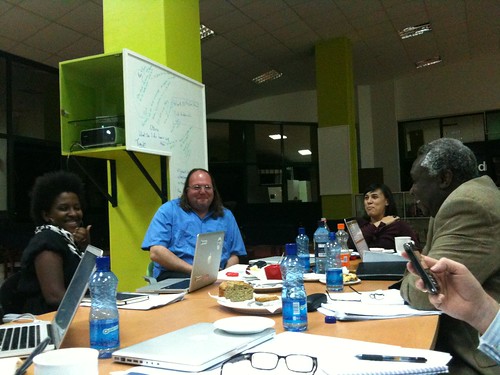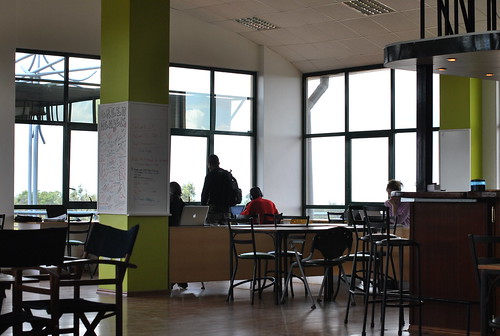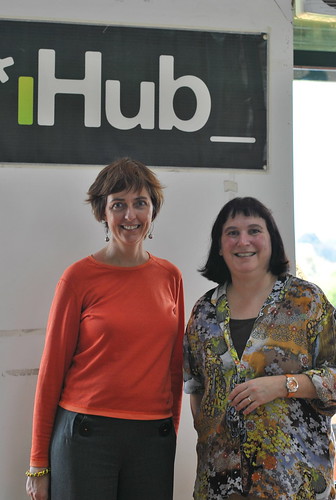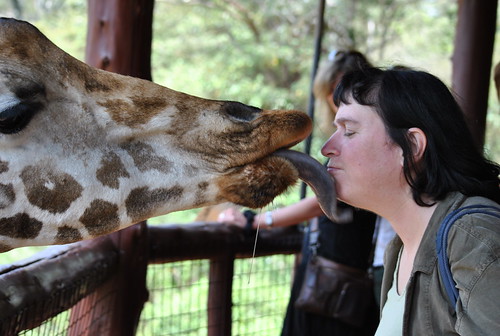
I’ve just spent the last couple of days in Nairobi, Kenya because I’m a board member of an NGO based here, Ushahidi, an organization that builds tools for democratizing information and increasing transparency. I decided to stay a few extra days and facilitate a workshop on the Networked Nonprofit for local NGOs. This blog post includes some reflections about my first visit to Africa, the importance of face-to-face meetings and building relationships, and some thoughts about how some of the ideas in the Networked Nonprofit transcend boundaries.
Ushahidi has had impressive growth over the past 18 months and most visible was its work with Haiti. What started as an ad hoc group of volunteers is growing into an impressive organization building out a platform that can be deployed for different purposes, from election monitoring to disaster relief. (Even in unintended and surprising ways). I also learned more about crowdmap, a hosted version of the Ushahidi code – in other words you don’t have to install it on your own web server.
I’ve had the honor of serving on the Ushahidi board for almost a year and have known two of Ushahidi’s co-founders, Ory Okolloh and Erik Hersman, for several years. Ushahidi’s board, like its staff, work together virtually across many time zones using different online tools for meetings and collaborative work. While virtual tools make it possible for a far-flung team to work with or for an organization that has global impact, I am reminded about the importance of “face time” for effectiveness – there is simply no other way to build relationships. One of the things I like best about being on the Ushahidi board is that it was acceptable for us be also on our laptops and smart phones – and even tweet during the meeting. Ethan Zuckerman, fellow board members, shares his impressions here.

The meeting and the workshop I facilitated took place in iHub, an open innovation space. The space is available to any tech person in Nairobi to use once they become a green member. With over 1900 members, the space offers a connection point and co-working space for the community, a fast Internet connection, lots of light, great views, and fantastic latte! I thought I had died and gone to heaven. I need to find a space like this in Silicon Valley for 2011.

In addition to the Networked Nonprofit, I brought copies of books from colleagues that might be of interest to local NGOs. This includes: Mary Joyce’s Digital Activism, Charlene Li’s Open Leadership, Jennifer Aaker’s DragonFly Effect, and Carol Cone’s Breakthrough Nonprofit Branding. Jessica Colaco who is the manager poses for a photo.

Just to illustrate how spaces like iHub act as connectors, while I was setting up for the workshop, Tiffany von Emmel, a colleague from San Francisco was in the room! She kindly live tweeted the workshop and took some photos.

I facilitated a workshop on the Networked Nonprofit, covering the concepts of social culture, simplicity, and transparency. I also hung out at the iHub and held “office hours” for folks who wanted to work one-on-one and go into more technical depth in using the tools. I was curious if these concepts were adaptable or relevant for NGOs in Kenya as it was my first time presenting these ideas in Africa. When I work outside of the US, my process is to listen and observe as much as possible. I also do not over prepare so I can be more flexible in the delivery and spark conversations around what is relevant or what isn’t.
It is always eye-opening to work on the social web from developing countries and realized just how spoiled we are in the US with fast and plentiful bandwidth. It requires a different way of working. I was most surprised how many online applications that I use daily in the US were slow loading and impossible to use. I was also surprised that Facebook loaded easily, even posting photos.
I did a lot of adjusting in real time and was very transparent with the group about this idea might get “lost in translation” or “not be relevant” and that’s okay. I designed share pair exercises that incorporated reflective questions about translation. A few learnings:
- Just Mibli (2)Words: I have been using an icebreaker called “Just Two Words.” I ask people to share what is top of mind when they think about social media and their NGO. I asked for the words in English or Swahili. The themes that emerged were identical to what I hear in the US, generally falling into these three themes: community, connections and concerns. Privacy and security were brought up, but I also heard the phrase “time .” I asked for clarification and the person indicated that social media takes a lot of time. I mentioned that in the US, we use the phrase “time suck” this was met with laughter. The idea of social media potentially being a huge time waster if not done effectively resonated with the group.
- Cultural Norms Around Instructional Delivery: I had learned that instructional delivery in Kenya tends to be very formal, mostly the “sage on the stage” lecture approach. I don’t teach that way. I favor a participatory approach with full room discussion. I had a wireless mic that was passed and included share pairs with reflective exercises. I felt some discomfort in the room at first, some hesitancy to speak up – there were some long silent pauses. Some of this also might have to do with gender roles. But after a couple of share pairs, the group warmed up and several folks took the mic and shared their ideas Needless to say I learned an enormous amount.
- What Surprised Me: On top of a concern that some of the ideas/content might not be relevant, I was worried that a lot of my verbal and visual humor might not translate either. And, terrified that I might inadvertently be insulting or appear rude. Humor is a natural part of my presentation style – so it came out. I surprised that people laughed at the some of the same jokes that they do in the US. Some concepts and ways of expressing them can be universal. While I didn’t do this on purpose, people thought my creative pronunciation of Kenyan names and understanding Kenyan accents was funny.
Translating Networked Nonprofits Ideas Into A Kenyan Context

- Learning from Mistakes: I talk a lot about the importance of learning from failing and rapid experimentation of small pilots using social media. I noticed that this resonated really, particularly the MomsRising approach of using “Joyful Funerals.” I set up the idea using the “I Can Make Better Choices Chair” photo that my son’s kindergarten class teacher used to teach the children self-reflection. I guess the idea of children needing to learn reflective practice is a universal because there was a lot of laughter in the room. Later, in the market, I saw this beautiful brass chair necklace (which I purchased).
- Fortress and Sponge: We use these metaphors in the book to discuss different approaches to transparency – with the fortress being less transparent. The image I used is one of a Russian fort. I asked the group if anyone worked for a fortress (some people raised their hands) and I also asked if those NGOs were ones from the US or new ones created in Kenya. (Response was laughter). The sponge metaphor was not quite right because I realized we were pretty fair from the Ocean. Nonetheless, this ideas prompted an interesting discussion about social media policy for NGOs.
- Simplicity: The concept of not having to do everything and focusing on what you do best and network the rest resonated. I learned later that simplicity is a very African concept. When I asked folks what they could do less of, I heard what I usually hear in the US: meetings. Perhaps there should be a global law to ban meetings in NGOs of more than 30 minutes! One participant’s takeaway was a wonderful translation of the simplicity concept: “Do less of the unnecessary to do more of the necessary.”

Book Giveaways
International travel has some restrictions on the weight of your suitcase, so I only could pack 10 books to giveaway (I was not able to find a sponsor to cover the luggage fees to bring a case of books) and I wanted to leave some room to bring books from colleagues. As part of the book raffle, I had people write down something they could put into practice on an index card and we did a drawing. Here’s a couple of the takeaways:
- Share more about what we’re doing on social networks to become less of fortress
- Identify specific, measurable outcomes for how we want to use social media to support our mission
- Have our organization become more like a Sponge
- Create a “I Can Make Better Decisions” chair for our office
- Identify conversation starters with our audience to engage them more on social networks
- Encourage our audience to share their stories, not just tell people what we do
Shoulder-to-Shoulder Learning
After the formal part of the workshop, I just hung out at iHub and engaged in a little “shoulder-to-shoulder” learning. Huddled around our laptops, I answered some nitty gritty questions about tools, shared resources (like the local TechSoup Global partner) and got to learn quite a bit about some NGOS in Kenya are putting social media strategies into practice – their successes and challenges. I find this quiet observation of how people interact with social networking sites one of the best ways to learn about how different cultures approach social media. I made some good friends like Zawadi Nyongo, a feminist social justice consultant and Kamau Sammy, who is starting an NGO to work with kids in Kenyan slums.
In this video, Wambui Gicheru and Njern Wangethi from African Woman and Children Feature Service and Ephraim Muchleau of the Media Council of Kenya talk about using Twitter for the organizations.

All in all, I loved my time in Kenya. I did get to spend an afternoon seeing some of the local sites, including the Elephant orphanage and Giraffe reserve where I got a warm welcome from one of the residents. I hope to return and spend more time here.
